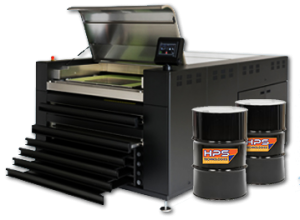
With a wide array of options available, it can be difficult to decide what new plate technology best fits your platemaking needs. New plate materials or platemaking processes are usually the first places you'll explore when considering an upgrade, but new processing equipment and solvent options can provide a substantial boost in both quality and productivity.
Consider this - if you're using a rotary-style solvent washout system, the plate is spending about three-quarters of it's time dwelling in solvent without being contacted by the brushes. In this scenario, plate swelling is a serious issue, and care must be taken to optimize the drying time so that the excess absorbed solvent is released. Drying times can easily reach 2 hours for an 0.067" plate in this scenario.
How can you minimize contact time with the solvent and maximize washout efficiency? There are two washout system designs that can accomplish this task: inline/incremental and batch. Let's explore these system designs in more detail:
Inline/Incremental Processing Systems
(examples: Mekrom EVO 5 IP, G&J Concept 405, Flint Nyloflex Washer FV)
These processors are ideal for high output platerooms due to their ability to be continually loaded with plates. They are typically large machines due to their inline construction. The washout configuration provides solvent to a designated washout section, where all unexposed polymer is removed as the plate moves passes through the washout brushes at a designated speed. Upon exiting the washout, immersion in solvent is terminated, minimizing solvent exposure to the plate.
Batch Processing Systems
(example: Mekrom EVO 2A, G&J Concept 205C)
Batch processing systems offer the advantage of a smaller footprint, while maintaining washout efficiency. This configuration features a large washout brush, or series of brushes, that maintain full coverage and constant agitation of the plate surface to maximize washout speed and minimize the plate's dwell time in solvent. The plate typically enters and exits through the same area of the machine, but there are some batch units that offer a separate plate entrance and exit.
Solvent Choices
The type of solvent you choose for your platemaking process can have a substantial impact on processing speed, plate quality, environmental impact, and overall costs. APR represents HPS-XO, a unique solvent option that offers quick washout and fast drying in an eco-friendlier formula. A main highlight of this unique solvent formula, HPS-XO does not require heating, which greatly reduces solvent consumption through evaporation and solvent absorption during processing by the plate. These factors increase productivity and lower overall costs by reducing drying time and decreasing energy usage throughout the platemaking process. Typical drying time for 0.067" plates processed with HPS-XO are in the 30 to 45 minute range. HPS-XO also offers environmental benefits such as lower VOC emission when compared to standard solvents. In addition, HPS Technologies has engineered a new formula, HPS-LO, to meet stringent EPA standards for safety while emitting less solvent odor.
So whether you're looking into upgrading your current plate or expanding into a new plate technology, APR can offer the experience and technical expertise needed to make the right choice for your operation. For more information, contact us here.
